RCA MR13401, M14300, M19401, M20300, CR14401 User Manual
...
TV User’s Manual
Changing entertainment. Again.
Before connecting, operating, or adjusting this product, please read this instruction booklet carefully and completely.
TOCOM 1547278B
Model: MR13401, MR14300, MR19401, MR20300, CR14401 & CR20401
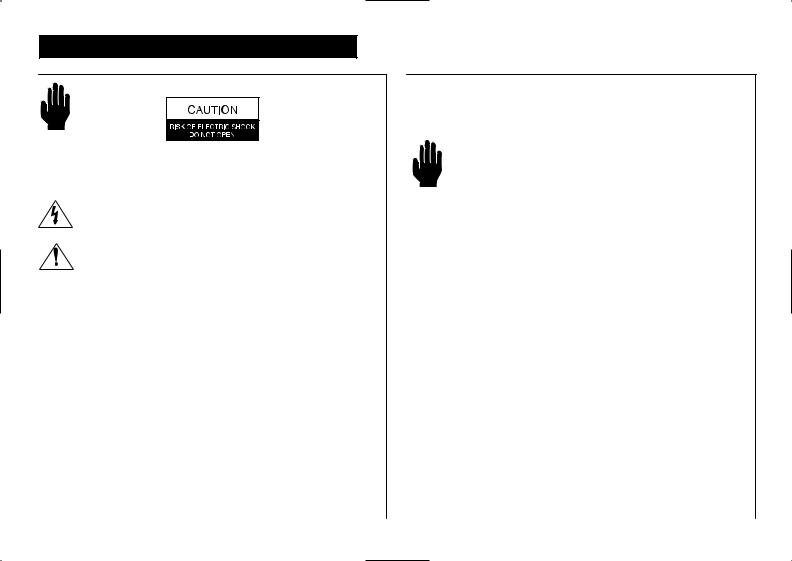
IMPORTANT SAFETY INSTRUCTIONS
Warning! Important Safety Instructions
CAUTION:
TO REDUCE THE RISK OF ELECTRIC SHOCK, DO NOT REMOVE COVER (OR BACK). NO USER SERVICEABLE PARTS INSIDE. REFER SERVICING TO QUALIFIED SERVICE PERSONNEL.
This symbol indicates high voltage is present inside. It is dangerous to make any kind of contact with any inside part of this product.
This symbol alerts you that important literature concerning operation and maintenance has been included with this product.
Power Consumption: 100-240V~50-60 Hz
52 Watts (Models MR13401 & CR14401)
60 Watts (Model MR14300)
65 Watts (Models MR19401 & CR20401)
70 Watts (Model MR20300)
Note to CATV system installer: This reminder is provided to call CATV system installer’s attention to Article 820-40 of the National Electrical Code that provides guidelines for proper grounding and, in particular, specifies that the cable ground shall be connected to the grounding system of the building as close to the point of cable entry as practical. Caution: To prevent electric shock, match the wide blade of plug to the wide slot, and fully insert the plug.
Important: One Federal Court has held that unauthorized recording of copyrighted TV programs is an infringement of U.S. copyright laws.
To prevent damage which may result in fire or electric shock hazard, do not expose this appliance to rain or moisture.
i.IMPORTANT SAFETY INSTRUCTIONS
Save These Instructions
Important Safety Information
Always be careful when using your TV receiver. To reduce the risk of fire, electrical shock, and other injuries, keep these safety precautions in mind when installing, using, and
maintaining your machine.
•Read all safety and operating instructions before operating the TV receiver.
•Retain the safety and operating instructions for future reference.
•Heed all warnings on the TV receiver and in the operating instructions.
•Follow all operating and use instructions.
•Unplug the TV receiver from the wall outlet before cleaning. Use a damp cloth; do not use liquid or aerosol cleaners.
•Never add any attachments and/or equipment without approval of the manufacturer. Such additions may result in the risk of fire, electric shock, or other personal injury.
•Do not use the TV receiver where contact with or immersion in water is a possibility, such as near bath tubs, sinks, washing machines, swimming pools, etc.
•Provide ventilation for the TV receiver. The unit is designed with slots in the cabinet for ventilation to protect it from overheating. Do not block these openings with any object, and do not place the TV receiver on a bed, sofa, rug, or other similar surface. Do not place it near a radiator or heat register. If you place the TV receiver on a rack or bookcase, ensure that there is adequate ventilation and that you’ve followed the manufacturer’s instructions for mounting.
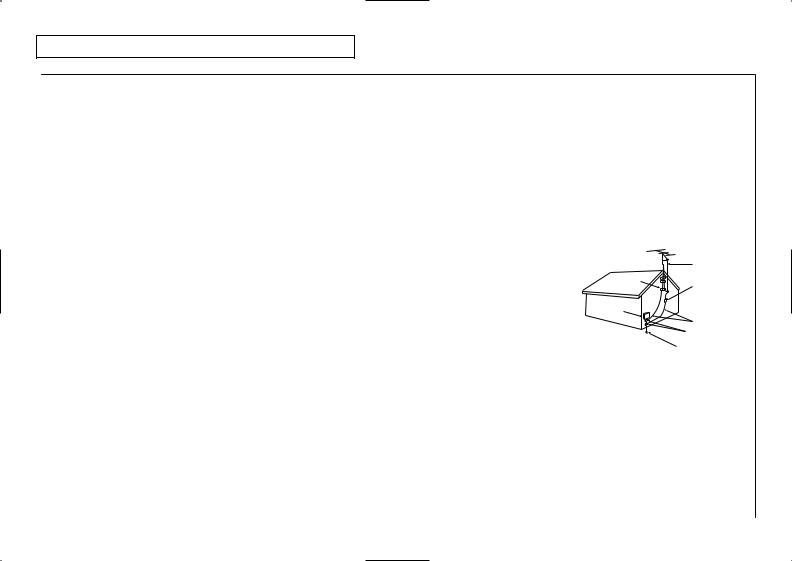
IMPORTANT SAFETY INSTRUCTIONS
Important Safety Information, continued
•Do not place the TV receiver on an unstable cart, stand, tripod, bracket, or table. The TV receiver may fall, causing serious injury to a child or adult, and serious damage to the appliance. Use only with a cart, stand, tripod, bracket, or table recommended by the manufacturer or sold with the TV receiver. Follow the manufacturer’s instructions
when mounting the unit, and use a mounting accessory recommended by the manufacturer. Move the TV receiver and its cart with care. Quick stops, excessive force, and uneven surfaces may cause the unit and cart to overturn.
•Operate your TV receiver only from the type of power source indicated on the marking label. If you are not sure of the type of power supplied to your home, consult your appliance dealer or local power company.
•Protect the power cord. Power supply cords should be routed so that they are unlikely to be walked on or pinched by items placed on or against them. Pay particular attention to cords at plugs, convenience receptacles, and the point where they exit from the unit.
•Unplug the TV receiver from the wall outlet and disconnect the antenna or cable system during a lightning storm or when left unattended and unused for long periods of time. This will prevent damage to the unit due to lightning and power-line surges.
Save These Instructions
•Avoid overhead power lines. An outside antenna system should not be placed in the vicinity of overhead power lines or other electric light or power circuits or where it can fall into such power lines or circuits. When installing an outside antenna system, be extremely careful to keep from touching the power lines or circuits. Contact with such lines can be fatal.
•Do not overload the wall outlet or extension cords. Overloading can result in fire or electric shock.
•Do not insert foreign objects through openings in the unit, as they may touch dangerous voltage points or damage parts. Never spill liquid of any kind on the TV receiver.
• Ground outdoor antennas. If an
outside antenna or cable system is connected to the TV
receiver, be sure the antenna or cable system is grounded so as to provide some protection against voltage surges and built-up static charges. Section
810 of the National Electrical
Code, ANSI/NFPA No.70-1984,
provides information with respect to proper grounding of the mast and supporting structure, grounding of the lead-in wire to an antenna discharge unit, size of grounding conductors, location of anten- na-discharge unit, connection to grounding electrodes, and requirements for the grounding electrode.
IMPORTANT SAFETY INSTRUCTIONS ii.

IMPORTANT SAFETY INSTRUCTIONS
Important Safety Information, continued
•Do not attempt to service the TV receiver yourself. Refer all servicing to qualified service personnel. Unplug the unit from the wall outlet and refer servicing to qualified service personnel under the following conditions:
-when the power-supply cord or plug is damaged
-if liquid has been spilled on or objects have fallen into the unit
-if the TV receiver has been exposed to rain or water
-if the TV receiver does not operate normally by following the operating instructions
-if the TV receiver has been dropped or the cabinet has been damaged
-when the TV receiver exhibits a distinct change in performance
If you make adjustments yourself, adjust only those controls that are covered by the operating instructions. Adjusting other controls may result in damage and will often require extensive work by a qualified technician to restore the TV receiver to normal.
•When replacement parts are required, be sure the service technician uses replacement parts specified by the manufacturer or those that have the same characteristics as the original part. Unauthorized substitutions may result in additional damage to the unit.
•Upon completion of any service or repairs to this TV receiver, ask the service technician to perform safety checks to determine that the TV receiver is in a safe operating condition.
Save These Instructions
iii.IMPORTANT SAFETY INSTRUCTIONS

CONTENTS
Chapter 1: Your New TV ........................................................ |
3 |
List of features . . . . . . . . . . . . . . . . . . . . . . . . . . . . . . . . . . . 3 Checking parts . . . . . . . . . . . . . . . . . . . . . . . . . . . . . . . . . . . 3 Learning about your new TV. . . . . . . . . . . . . . . . . . . . . . . . 4 Front panel jacks, buttons and indicators . . . . . . . . . 4 Rear panel . . . . . . . . . . . . . . . . . . . . . . . . . . . . . . . . . . . 4 Remote control . . . . . . . . . . . . . . . . . . . . . . . . . . . . . . . 5
Chapter 2: Installation ........................................................... |
6 |
Connecting VHF and UHF antennas. . . . . . . . . . . . . . . . . . 6 Antennas with 300-ohm flat twin leads . . . . . . . . . . . 6 Antennas with 75-ohm round leads . . . . . . . . . . . . . . 7 Separate VHF and UHF antennas . . . . . . . . . . . . . . . . 7 Connecting cable TV . . . . . . . . . . . . . . . . . . . . . . . . . . . . . . 7 Cable without a converter box . . . . . . . . . . . . . . . . . . 7 Cable with a converter box . . . . . . . . . . . . . . . . . . . . . 7 Connecting a VCR . . . . . . . . . . . . . . . . . . . . . . . . . . . . . . . . 8 Connecting a camcorder . . . . . . . . . . . . . . . . . . . . . . . . . . 9 Installing batteries in the remote control . . . . . . . . . . . . . 9
Chapter 3: TV Operation ........................................................ |
10 |
Turning the TV on/off . . . . . . . . . . . . . . . . . . . . . . . . . . . . . . 10 Viewing the menus . . . . . . . . . . . . . . . . . . . . . . . . . . . . . . . 10 Seeing special help . . . . . . . . . . . . . . . . . . . . . . . . . . . . . . . 11 Selecting the menu language. . . . . . . . . . . . . . . . . . . . . . . 11 Memorizing the channels . . . . . . . . . . . . . . . . . . . . . . . . . . 12
Storing channels in memory . . . . . . . . . . . . . . . . . . . . 12 Adding and erasing channels . . . . . . . . . . . . . . . . . . . 12 Fine tuning channels . . . . . . . . . . . . . . . . . . . . . . . . . . 13 Changing channels . . . . . . . . . . . . . . . . . . . . . . . . . . . . . . . 14 Using the channel buttons. . . . . . . . . . . . . . . . . . . . . . 14 Directly accessing channels . . . . . . . . . . . . . . . . . . . . 14 Scanning the channels . . . . . . . . . . . . . . . . . . . . . . . . 14 Selecting the previous channel . . . . . . . . . . . . . . . . . 14 Setting the clock . . . . . . . . . . . . . . . . . . . . . . . . . . . . . . . . . 15 Adjusting the volume. . . . . . . . . . . . . . . . . . . . . . . . . . . . . . 16 Raising or lowering the volume . . . . . . . . . . . . . . . . . 16 Using mute . . . . . . . . . . . . . . . . . . . . . . . . . . . . . . . . . . 16 Customizing the picture. . . . . . . . . . . . . . . . . . . . . . . . . . . . 16 Using Automatic Picture . . . . . . . . . . . . . . . . . . . . . . . . . . . 17 Viewing the on-screen displays . . . . . . . . . . . . . . . . . . . . . 18 Setting the Sleep Timer . . . . . . . . . . . . . . . . . . . . . . . . . . . . 18 Viewing a VCR or camcorder tape. . . . . . . . . . . . . . . . . . . 18
CONTENTS 1

CONTENTS |
|
Chapter 4: Special features |
..................................................19 |
Setting the On/Off Timer . . . . . . . . . . . . . . . . . . . . . . . . . . . |
19 |
Using the SKIP TIMER. . . . . . . . . . . . . . . . . . . . . . . . . . . . . |
20 |
Viewing Closed Captions. . . . . . . . . . . . . . . . . . . . . . . . . . . |
21 |
Appendix.................................................................................. |
22 |
Troubleshooting . . . . . . . . . . . . . . . . . . . . . . . . . . . . . . . . . . 22 Identifying problems. . . . . . . . . . . . . . . . . . . . . . . . . . . 22 Cleaning and maintaining your TV . . . . . . . . . . . . . . . . . . . 23 Using your TV in another country . . . . . . . . . . . . . . . . . . . 23 Specifications. . . . . . . . . . . . . . . . . . . . . . . . . . . . . . . . . . . . 23
2 CONTENTS

CHAPTER ONE |
YOUR NEW TV |
List of features |
Checking parts |
Your TV was designed and engineered using the latest technology. This TV is a full-featured, high-performance unit that not only meets, but exceeds, industry standards. Along with the standard features you expect, your TV includes the following special features:
•Easy-to-operate remote control
•Easy-to-use on-screen menu system you can use from the front panel or the remote control
•Automatic timer to turn the TV on and off at any time you choose
•Special picture settings, pre-set at the factory for the highest resolution
•Automatic channel tuning for up to 181 channels
•A previous channel button to quickly see the last channel you were viewing
•Fine tuning control for the sharpest picture possible
•A special sleep timer
•Tri-lingual on-screen displays (English, Spanish, and French)
Once you have unpacked your TV, check to make sure that you have your remote control.
CHAPTER ONE: YOUR NEW TV 3
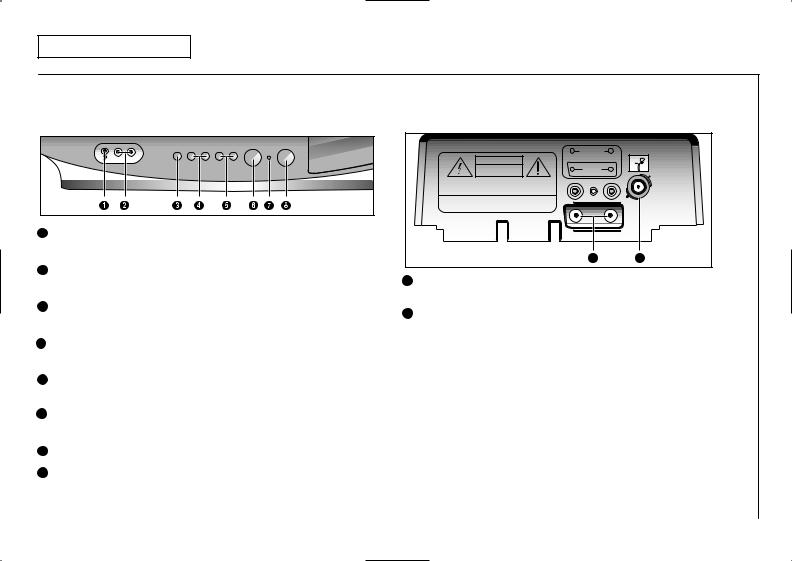
YOUR NEW TV
Learning about your new TV
Front panel jacks, buttons and indicators
MENU |
- VOL + |
POWER |
▲ CH ▲ |
||
|
|
STAND BY |
VIDEO-IN-AUDIO |
|
|
1
1EARPHONE jack Connect a set of external earphones to this jack for private listening.
2VIDEO and AUDIO input jacks Use these jacks to connect a camcorder or video game.
3MENU Press to see an easy-to-use on-screen menu of your TV’s features.
4– VOL and VOL + Press to change the volume or to change features on the menu.
5CH ▼ and CH ▲ Press to change channels or to select features on the menu.
6Remote Control Sensor Aim the remote control towards this spot on the TV.
77 |
STAND BY Lights up when you turn the power off. |
8 |
POWER Press to turn the TV on or off. |
The front panel above shows a typical button layout. The exact look of the buttons may be different from those on the front of your TV.
Rear panel
|
OUTPUT |
|
|
CAUTION |
VIDEO |
AUDIO |
75 |
RISK OF ELECTRIC SHOCK. |
INPUT |
|
|
DO NOT OPEN. |
|
|
|
CAUTION : TO PREVENT ELECTRICAL SHOCK, DO NOT REMOVE |
|
|
|
THIS COVER. NO USER-SERVICEABLE PARTS INSIDE. |
|
|
|
REFER SERVICING TO QUALIFIED SERVICE PERSONNEL. |
|
|
|
WARNING : TO PREVENT DAMAGE WHICH MAY RESULT |
|
|
|
IN FIRE OR SHOCK HAZARD, DO NOT EXPOSE THIS |
|
|
|
APPLIANCE TO RAIN OR MOISTURE. |
|
|
|
|
1 |
|
2 |
1VIDEO and AUDIO input jacks
Use these jacks to connect a VCR or other video equipment.
2VHF/UHF Antenna terminal
Use this terminal to connect an outdoor antenna or cable system.
For information on connecting equipment, please see page 6.
4 CHAPTER ONE: YOUR NEW TV
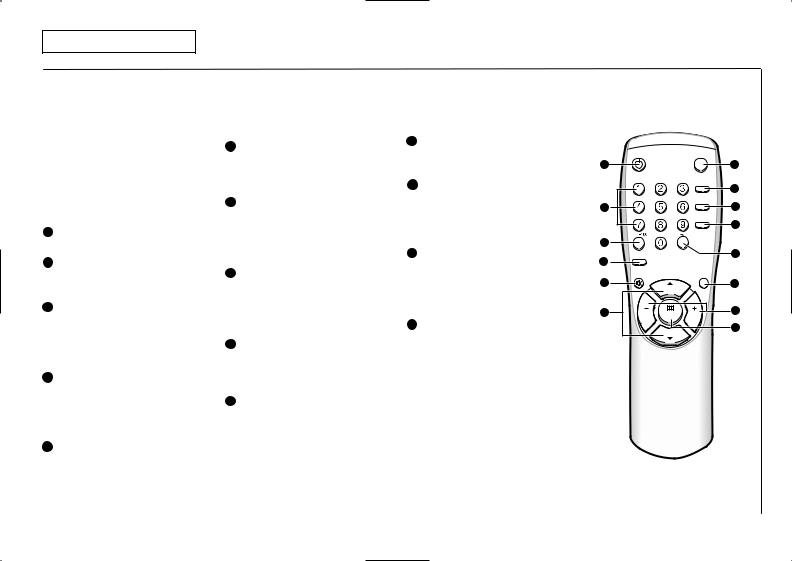
YOUR NEW TV
Learning about your new TV, continued
Remote control
You can use the remote control up to a distance of about 23 feet from the TV. When using the remote, always point it directly at the TV.
1POWER
Press to turn the TV on and off.
2Number buttons
Press to directly select channels on the TV.
3+100
Press to directly select channels over 100. For example, to select channel 121, press +100, then press 2 and 1.
4SKIP TIMER
Press when viewing a channel to automatically return to that channel after an amount of time that you set.
5MUTE
Press to mute (silence) the volume.
6CH▲ and CH▼ (Channel)
Press CH ▲ or CH ▼ to change channels. Also use with the onscreen menu system.
7TV/VIDEO
Press to watch TV picture and a picture from a connected component (VCR, LDP etc.).
38 P-STD
Press to adjust the TV picture by selecting one of the special factory settings or your own custom setting.
9CH-SCAN (Channel Scan)
Press to have the TV automatically scan all of the channels it has memorized.
10SLEEP
Press for the TV to automatically turn off after an amount of time that you set.
11PRE-CH (Previous Channel)
Press to see the last channel you were watching.
12DISPLAY
Press to see the time, channel, etc., on-screen. Also press to exit (quit) the menu system.
137 VOL – and VOL + (Volume)
Press VOL – to lower the volume; press VOL + to raise the volume. Also use with the menu system.
14CDMENU
Press this button to see the easy-to-use menu system.
|
POWER |
|
TV/VIDEO |
|
1 |
|
|
|
7 |
|
|
|
P-STD |
8 |
|
|
|
|
|
2 |
|
|
CH-SCAN |
9 |
|
|
|
||
|
|
|
SLEEP |
10 |
|
|
|
|
|
|
|
PRE-CH |
|
|
3 |
|
|
|
|
4 |
SKIP TIMER |
|
|
11 |
|
|
|
|
|
|
MUTE |
|
DISPLAY |
|
5 |
|
CH |
|
12 |
|
|
|
|
|
6 |
VOL |
MENU |
VOL |
13 |
|
|
CH |
|
14 |
|
|
|
|
CHAPTER ONE: YOUR NEW TV 5
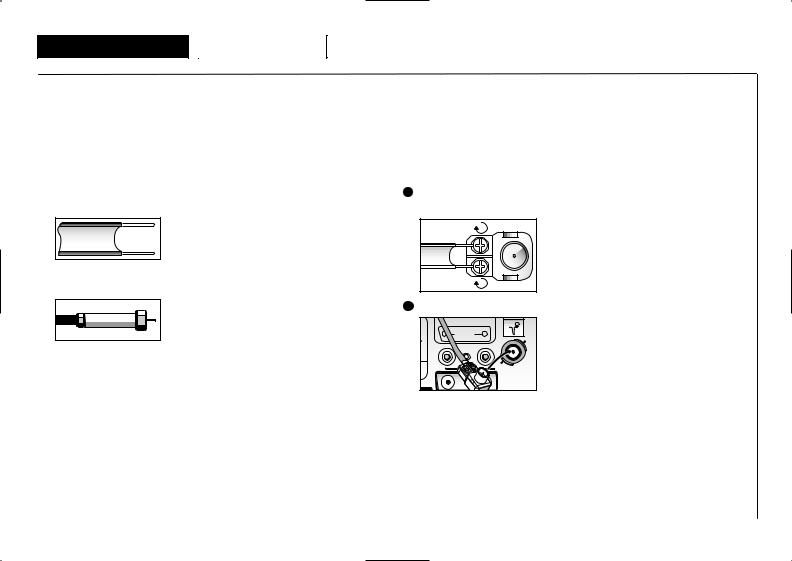
CHAPTER TWO INSTALLATION
Connecting VHF and UHF antennas
If you do not have cable TV, you will need to connect an antenna to your TV. To connect an antenna, follow the instructions in one of the following sections.
•If your antenna has a set of leads that look like the illustration below, see “Antennas with 300-ohm Flat Twin Leads,”on this page.
•If your antenna has one lead that looks like the illustration below, see “Antennas with 75-ohm Round Leads,” on page 7.
•If you have two antennas, see “Separate VHF and UHF Antennas,” on page 7.
Antennas with 300-ohm flat twin leads
If you are using an off-air antenna (such as a roof antenna or rabbit ears) that has 300-ohm twin flat leads, follow the directions below.
1Place the wires from the twin leads under the screws on the 300-75 ohm adapter. Use a screwdriver to tighten the screws.
22 Plug the adapter into the terminal on the bottom of the back panel.
AUDIO |
75 |
6 CHAPTER TWO: INSTALLATION
